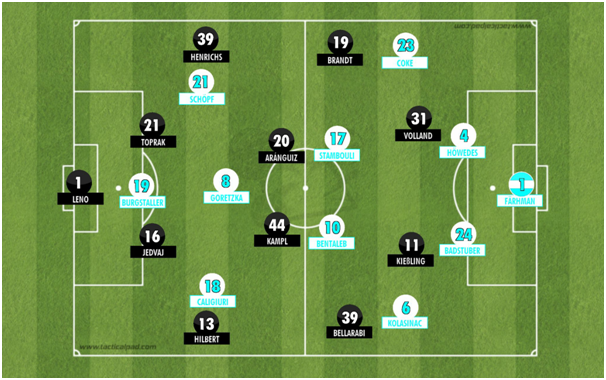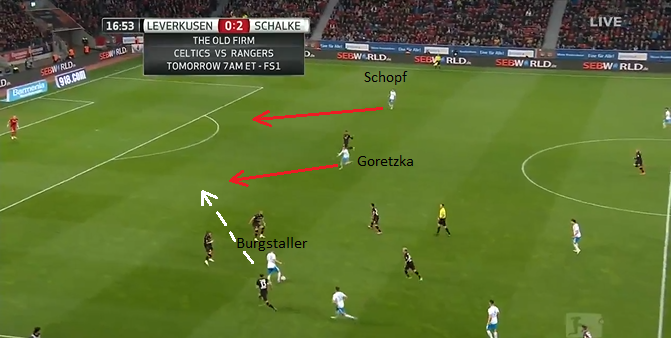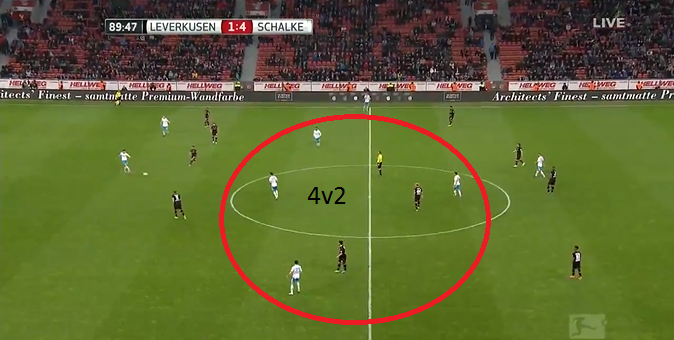Tomislav Brezovic writes a detailed tactical analysis about the Bundesliga match that ended Bayer Leverkusen 1-4 Schalke.
All leagues have underachievers and in Bundesliga those clubs are definitely Bayer Leverkusen and Schalke. Bayer, former UEFA cup winners and Schalke, 7 time former winners of Bundesliga, currently reside in the middle of the table next to each other. Both clubs are fighting for a European spot and defeat for either could put them in a tough situation, with Schalke in a slightly better position being two points ahead of Leverkusen. Schalke achieved a convincing 4-1 win but that result doesn’t paint a clear picture about the happenings in the game. If some situations turned in Leverkusen’s favour, the positive result would be on their side. Leverkusen missed some good chances and Schalke scored three goals from three chances and after that it was very difficult to chase the game. Nevertheless, Leverkusen had problems in pressing and in their passing combinations in the opponent’s half whilst Schalke was clinical with their finishing and put in a good defensive performance which led to a deserved win. At the end of the match Schalke could have won by an even bigger margin.
Line Ups

Made using TacticalPad
Leverkusen (4-4-2): Leno, Hilbert (Wendell 46’), Jedvaj, Toprak (Tah 19’), Henrichs, Kampl, Aranguiz, Bellarabi, Brandt (Mehmedi 85’), Kiessling, Volland
Schalke (4-2-3-1): Farhman, Coke, Howedes, Badstuber, Kolašinac (Aogo 74’), Stambouli, Bentaleb (Reither 84’), Schopf, Goretzka, Caligiuri, Burgstaller
Goals: 69’ Kiessling / 6’, 50’ Burgstaller, 10’ Howedes, 18’ Schopf
Die Werkslef coach Tayfun Korkut decided to make five changes from the match against Freiburg. In terms of formation, it was a 4-4-2 with double pivots, Henrichs replaced Wendel as the left fullback, Jedvaj played as a center back instead of Dragovic, Aranguiz came into team instead Baumtgartlinger, and Bellarabi replaced Kai Havertz on the right wing, after the German youngster had to study for school exams. The last change was Kiessling for Chicharito.
Schalke’s coach Markus Weinzierl switched formation. Against RB Leipzig, he played in a 4-2-2 formation, but for the match against Leverkusen, he decided to operate in a 4-2-3-1. Huntelaar stayed on the bench and the only center forward was Burgstaller. Schopf started the game as he replaced the injured Meyer.
Leverkusen’s strong entry and early blow
In the first minute of the game, Leverkusen had a clear cut chance. Bellarabi stole the ball, passed the ball behind Howedes, and Brandt ran onto the ball. Brandt shot and Fahrmann saved great chance for Die Werkslef. Shortly after that, another chance fell to Leverkusen. Volland shot from the edge of the box and the ball finished slightly above the bar. At the start of the game, Leverkusen created a few chances and they even controlled the rhythm of the game through their pressing and counterpressing, which was at a high level. In transitional moments they often had many players around the ball. Especially the Slovenian international Kevin Kampl who was great in these areas and through the game, he made 13 ball recoveries. Kampl is a well known gegenpressing machine. It’s enough to know that Klopp and Roger Schmidt were his coaches (Schmidt on two occasions, Salzburg and Leverkusen), which tells you a lot about the type of player he is.

Leverkusen’s counterpressing
Leverkusen looked good and forced Schalke to play long or on the flanks. Volland and Kiessling attacked the centerbacks and 2v2 situations appeared. Leverkusen strikers tended to block passes to Bentaleb and Stambouli by using cover shadows. If passes to Schalke’s defensive midfielders were possible, then Kampl and Aranguiz would advance up and acted in a man oriented approach towards Bentaleb and Stambouli. Wingers Brandt and Bellarabi controlled Die Konigsblauen fullbacks. This pressing structure in the beginning of the game was effective. Schalke struggled to organize the attack and nothing indicated that this would be Schalke’s night.

Leverkusen in high pressing
But Schalke took the lead in the 6th minute. Bentaleb played a through ball in the manner of Iniesta for Goretzka who ran past Henrichs and received the ball. Toprak challenged him and Goretzka played the pass to Burgstaller who was alone and scored into the empty net because Leno had rushed towards Goretzka. Three minutes later it was 2-0 for Schalke. Howedes scored a header from a corner taken by Schopf. Leverkusen was better but Schalke scored the goals, two goals from two shots. Leverkusen had a good opening period for about 15 minutes and then things started to change and Leverkusen began to decline; the only thing that remained the same was that Schalke continued to score goals.
Leverkusen problems
After a good start, the problems started to come. They were visible in the high pressing and stray passes in the attacking third. With respect to high pressing, it was functioning very well until one small detail was changed in Schalke’s build up. That detail was dropping one of Schalke’s midfielders, Bentaleb or Stambouli between centerbacks to create a back three against two of Bayer’s forwards. This was a problem because Leverkusen didn’t adjust their high pressing to the new situation. Volland and Kiessling continued to attack the center backs, but now they had a larger distance to cover because of the three Schalke players in the back line. Bellarabi and Brandt didn’t help their center forwards in that situation because they were man oriented to Schalke’s fullbacks. And after Schalke’s fast horizontal ball circulation in back line, space was opened for the center back to advance. Because of large distance Volland and Kiesling didn’t have any connection to the ball far center back when play was switched to that center back. When that center back advanced with the ball, Leverkusen’s wingers attacked him and they left the fullback unmarked. The center back passed to the fullback, who had the highway in front of him.

Howedes has more time on the ball and attracts pressure of Brandt and passes to Coke who is unmarked and advanced forward with the ball.
Schalke’s third goal came because of that problem and Hilbert’s rushed intervention. Badstuber had time on the ball and Bellarabi attacked him and left Kolašinac alone. Badsutuber played a pass into the middle to Bentaleb, Hilbert attacked Bentaleb instead of staying in his position and transferred the worry about Bentaleb to Kampl. Hilbert’s rushed movement caused large instability in Bayer’s defensive shape. Bentaleb played a pass to Kolašinac and after several quick combinations Goretzka came into a good chance.

Burgstaller plays a pass to Goretzka, Schalke’s third goal
Goretzka shot two times and Leno saved both shots. Leverkusen players managed to get back in the box but the second Goretzka shot deflected to Schopf who scored for the 3-0.
Some would say that this is Tayfun Korkut’s fault because the team didn’t react to the new situation. There are many ways to disturb the build-up play of a back three; the fullbacks could be closer with Hilbert or Henrichs advancing high. We often saw this type of pressing under Roger Schmidt. If the coach wants greater defensive stability from the back line then the central midfielder is a better choice to press the fullback. It cannot be allowed that if a pass bypasses the winger the receiving fullback remains unmarked. These are some of the options for how to challenge a fullback if the winger decides to attack the full back. Which approach the coach will use in the end depends on the style the coach has and what is the structure of the opponent in their attacking phase.
One more problem that Leverkusen had through the game was how to establish passing rhythm in the attacking third. Leverkusen mainly played the game through the wings because Schalke had good central coverage. When they came to the attacking third they managed to make passing diamonds and triangles through Brandt who drifted inside and their very active forwards and defensive midfielders Kampl and Aranguiz, but there were a lot of wrong passes and Leverkusen couldn’t find that final pass. Bellarabi also tried to provide passing options in the center but rarely in the manner that Brandt did. The reason is Bellarabi’s dribbling abilities and pace which needed to be used on the flank.

Leverkusen passes in attacking third, via fourfourtwo.com
Schalke’s approach
Schalke had a strong tendency to play through wings while in possession. There are several reasons that encouraged them to do that.
One reason is mentioned above and that is the positioning and activity of Bellarabi and Brandt during their high pressing. The other reason is Leverkusen’s compact shape that blocked passes into the middle and forced play onto the wings. Also Bayer’s counterpressing forced Schalke to play backwards or on the wings. One more detail that provoked Schalke to pass on the wing is Brandt’s positioning in the center of the field. Brandt often played in the middle, during counterpressing and when Leverkusen were in possession, drifting inside to provide a passing option. This opened the space on the right flank for Schalke if they managed to beat Leverkusen’s press. With regard to Brandt’s central positioning, when Bayer were in an attacking phase, in some situations space was opened which Brandt didn’t reach on time due to distance he had to cover.

Schalke passmap, via 11tegen11
As seen on the passmap, it’s clearly visible that Schalke’s strategy is based around the flanks. They have created passing triangles on both flanks. On the left flank, combinations were executed due to the close positioning of Kolašinac, Bentaleb and Caligiuri and on the right by Coke, Goretzka and Schopf. Stambouli was the player whose role was to switch sides and organizing attacks from a deep position as he received many balls from the center backs. Burgstaller was also actively working to provide passing options on the left and right side.
When Schalke took a 2-0 lead they stopped pressing high and they pressed rarely. They concentrated on creating a compact 4-4-2 block and preventing Leverkusen from playing through the middle.

Schalke’s deep 4-1-4-1 block
When Leverkusen got to Schalke’s defensive third, it was difficult to penetrate their 4-1-4-1 block with Stambouli guarding between the lines. Schalke defended well and it was a very difficult task for Leverkusen to chase those three goals down.
Chaotic second half
Leverkusen was desperate to score in second half and they started to press even more aggressively. This created many transition moments and resulted in many battles for the second and third balls. Leverkusen’s aggressive approach on some occasions was executed individually and not collectively and this opened large gaps between the lines and heavy disorganization in Leverkusen’s defensive shape whilst Schalke were very dangerous on the counter attacks. In the second half Schalke stopped creating a back three, and one of Schalke midfielders didn’t drop between the center backs. This was due to Schalke’s comfortable lead and Schalke reduced their risk playing out from the back and often played long to bypass Bayer’s pressing. With that approach Schalke got one more player in the center who could fight for second and third balls and reduce Leverkusen’s chance to win the ball high up the pitch.

Aggressive pressing by Leverkusen
The image above is a scene from the last minutes of the game that shows aggressive pressing by Leverkusen. Their compactness is disastrous and in the middle of the pitch Schalke has a 4v2 numerical advantage.
Leverkusen created a few chances in the second half but they only managed to score one goal via Kiesling and they didn’t turn up the match which was a difficult job by itself.
Conclusion
With that loss, Leverkusen was sent into the relegation battle being only three points ahead of HSV who hold the position which leads towards relegation playoff game against a club in the second division. After the game Korkut’s longterm future is doubtful but Die Werkslef sporting director Rudi Voller said that Tayfun Korkut will be surely in charge until the end of the season. With respect to Die Konigsblauen, they continued their fight for Europa League and the final Europa League spot is only four points away.
Read all our tactical analyses here























































